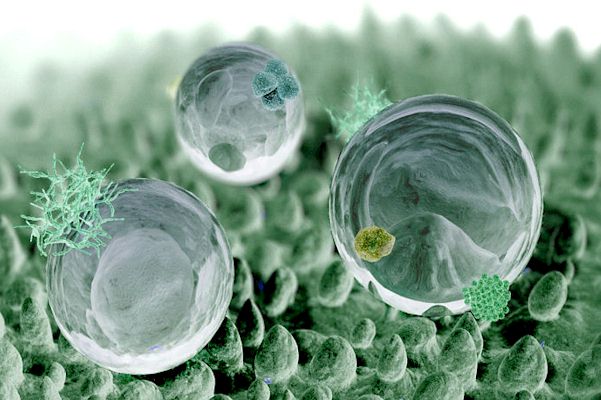|
April 2008 |
||||
| Lotusan Paint and Superhydrophobicity | ||||
|
Biomimicry involves the study of natural
biological systems and how these systems can be used to design and
engineer technological solutions. Velcro is an example of this transfer
of technology from a natural system to a manmade system. George de
Mestral, a Swiss engineer, was cleaning burrs from his dog's coat when
he realized how the hooks of the burrs stuck to the loops of the fur.
Another example of how a natural system can be used to solve a technological problem is an amazing paint called Lotusan. A surface painted with Lotusan mimics the behavior of the superhydrophobic lotus leaf. Water will not adhere and in fact when it rolls off, it will pickup debris and makes the Lotusan-painted surface self-cleaning. In a commercial environment this not only reduces maintenance labor and improves the cleanliness of architectural surfaces, but also reduces the use of toxic and environmentally harsh cleaning solutions.
Cassie's Law explains how the change to surface nanotopology (or roughness) can increase the contact angle. Water striders effortlessly float on water not because of any special chemical properties found on them, but because of the unique nanostructures found on their legs. Super hydrophobic films such as Lotusan paint also exploit this law. In addition to the self-cleaning property, Lotusan surfaces stay dry and are thus highly resistant to mold, mildew, and algae, and act as an excellent vapor barrier. Lotusan is the brainchild of German inventor Wilhelm Barthlott who also claimed the use of "Lotus-Effect" which in the US is a registered trademark of Sto Corporation, the US arm of the German company Sto AG. Lotusan is one of the first of many commercially available products that employs the lotus-effect to reduce wetting, provide self-cleaning, and promote other desirable characteristics. The Ferro Corporation has developed self-cleaning coatings for glass. Erlus-Lotus is the first commercial self-cleaning roof to use the lotus effect. Nanopin film is an example of another new technology with superhydrophobic properties. Contact angles of 178° have been achieved on this amazing experimental material made up of many nanoscopic pins and cones based on a fractal structure. There are myriad commercial applications for lotus-effect technology: toll-booth sensors, frying pans, raincoats and boots, shower walls, eye glasses, windshields, shingles, silverware and serving spoons, billboards and signs. As this exciting technology develops, look for many new products and applications that can benefit from a man-made Lotus-like surface. Superhydrophobicity is easily measured with any
ramé-hart contact angle goniometer and is typically defined by contact
angles in excess of 150°. Additionally, the contact angle hysteresis is
typically very low, under 5°, and roll-off angle (as measured with a
ramé-hart tilting base) is also low, under 8°. |
||||
|
||||



